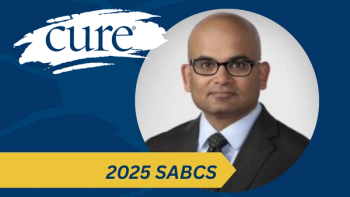
- CURE® Summer 2022
Teaching Others Through Cancer Advocacy
One patient turned her diagnosis of multiple myeloma into a way to educate others as an advocate.
Even though treatment for multiple myeloma forced Cindy Chmielewski to retire from her 29-year career in teaching, she continues to be a lifelong educator, pivoting her focus from teaching science at an elementary school to educating others about multiple myeloma. As the self-proclaimed “Myeloma Teacher” on Twitter and Facebook, she shares resources from her home in Lawrenceville, New Jersey, with patients and families around the world.
She also uses social media to share her experiences with multiple myeloma, including the time when finding an effective treatment seemed nearly impossible. Chmielewski, 62, advises patients, including those around her age, to step out of their comfort zone and ask the questions to potentially lead them to a treatment plan that’s right for them sooner rather than later.
“It’s important (that) I always share my story,” Chmielewski said in an interview with CURE®. “A lot of people are like me because the disease is a disease mostly of older patients. There’s a lot of people who were brought up in that age of ‘doctor knows best,’ so they don’t want to ask questions.”
Navigating Diagnosis and Treatment
Starting in 2006, Chmielewski received treatment for degenerative disc disease, which provided her no relief for her severe back pain. It wasn’t until 2008 when X-rays indicated that she had compound fractures in her spine. Before undergoing surgery to potentially relieve the pain, Chmielewski had blood drawn, which came back “very abnormal.”
This led to an appointment with a hematologist, who gave Chmielewski, then 49, a diagnosis of stage 3 multiple myeloma, the most advanced stage of this type of cancer.
“Myeloma attacks your bones, so all that back pain was (from) compression fractures,” Chmielewski said. “In that time, I lost 3 and a half inches of height due to the compression fractures.”
Chmielewski started treatment immediately with Revlimid (lenalidomide) and dexamethasone, although she went into it somewhat blindly.
“The reason I chose Revlimid and dexamethasone was because they were oral drugs, and I could continue teaching taking these drugs,” Chmielewski said. “I didn’t ask the questions I should have been asking, like: What’s the efficacy? What are the side effects? How much is it going to cost me? What were the trials? All those questions that were normal questions, (and) mine was, ‘Oh, it’s oral, I guess I could continue teaching.’ That’s how naive I was.”
The doublet therapy worked on Chmielewski’s multiple myeloma for three cycles, which led her cancer team to add a third drug — Velcade (bortezomib) — to her treatment regimen. This also didn’t help too much, so she underwent a stem cell transplant.
Unlike Chmielewski, patients are often in remission when undergoing a stem cell transplant, and hers was aimed at putting her into remission. But 100 days after her stem cell transplant, she still had multiple myeloma.
“I was so devastated,” Chmielewski said. “That was a sadder day than the day I was diagnosed (with multiple myeloma) because the day I was diagnosed, I had never heard of multiple myeloma before. (I was) thinking, ‘I know nothing about it. It can’t be that bad.’ … So that was more devastating because now I thought I was completely out of options. I mean, this really barbaric type of treatment failed to put me into remission.”
It was at this time that Chmielewski, then 50, decided to retire from teaching so she could dedicate her time to exploring other treatment options, including clinical trials. After trying a few more regimens, including ones with Thalomid (thalidomide), she suddenly started to respond to her initial treatment with Revlimid, dexamethasone and Velcade.
Over the next two years on that specific treatment, she started deriving a maximum response, although it was never a complete response (the disappearance of all signs of cancer from treatment). For the past 13 years, Chmielewski has been on Velcade maintenance therapy.
“I’ve been living with this disease that, at the time of my diagnosis, they said maybe four to six years, and now it’s over 13 (years),” Chmielewski said. “I turned (into a) teenager this year from my stem cell transplant anniversary and 14 years of living with myeloma.”
Educating Others Through Educating Oneself
In 2009, when Chmielewski was home from her stem cell transplant, she started gathering resources online and saving them to folders in her AOL account because “being a teacher, that’s what I like to do in educating myself,” she said.
She wanted a way to share this information with other people, and that’s when she had her lightbulb moment. She was watching the “Today” show, and Kathie Lee Gifford and Hoda Kotb were promoting their Twitter accounts. Chmielewski created a Twitter handle just to follow the two hosts. While searching for “myeloma” on Twitter, she saw that people including doctors were tweeting about her disease. She started following the doctors and patients she came across during her research.
Chmielewski changed her Twitter handle to @MyelomaTeacher and started using #MMSM (multiple myeloma social media) as a hashtag to make herself stand out with the resources she was sharing.
“When I started gaining followers on Twitter, I said, ‘Well, then I better start putting out really good stuff,’” Chmielewski said. “It became a game, like: Can I get the doctors to follow me, too? … Then it was no longer a game. I was like, ‘Well, I really have a purpose. I could start educating others using this.’ I started gaining more and more followers. I guess more and more people started to see me and what I was doing.”
Chmielewski also started a Facebook account to accompany her Twitter account since “people with myeloma tend to be older, and Facebook was more comfortable to them than Twitter,” she said.
She also looked at what advocates in the breast cancer space were doing on social media to potentially implement those tactics into the multiple myeloma social media space. Chmielewski joined Tweet chats and became friends with many patients within the breast cancer community. This is how she learned more about attending organizational meetings, volunteering and other programs to advocate in other ways.
Through Chmielewski’s activity on Twitter and Facebook, she has received messages from patients and family members alike, thanking her for sharing the information she has obtained about this disease.
“That’s the beauty with Twitter: It’s around the entire world,” Chmielewski said. “If you look at my followers, they’re not just here in the United States; they’re global, and just helping some people in areas of the world that have no access to patient education and just sharing those resources with them, it’s incredible, and connecting them with maybe someone who could help them.”
This recently happened as a result of a Facebook post in a closed group, where a young patient with multiple myeloma living in Norway said she had no other treatment options. Chmielewski connected her with a doctor she had met at an International Myeloma Workshop meeting in Austria who was also from Norway. He gave Chmielewski his personal telephone number and his email address and told her to have the patient to contact him to see what he could do.
Although she doesn’t know exactly what came out of that connection, Chmielewski said it’s rewarding to attend these meetings and make connections, in addition to sharing information with patients who may not be able to attend the meetings.
Chmielewski credits connections like these and the many others she has made throughout her multiple myeloma journey for bringing her out of the depression she was in after she retired because of her disease.
“I thought I was depressed back then, 10 years ago, thinking I was going to be bored and have nothing to do,” she said. “Now I have too much to do, but I enjoy it.”
For more news on cancer updates, research and education, don’t forget to
Articles in this issue
over 3 years ago
Using Effective Cancer Therapies Earlier — Does It Always Work?over 3 years ago
How Patients With Cancer Can Best Care For Their Chemo Portover 3 years ago
Uncovering New Ways to Make Cancer Surgery Safer



